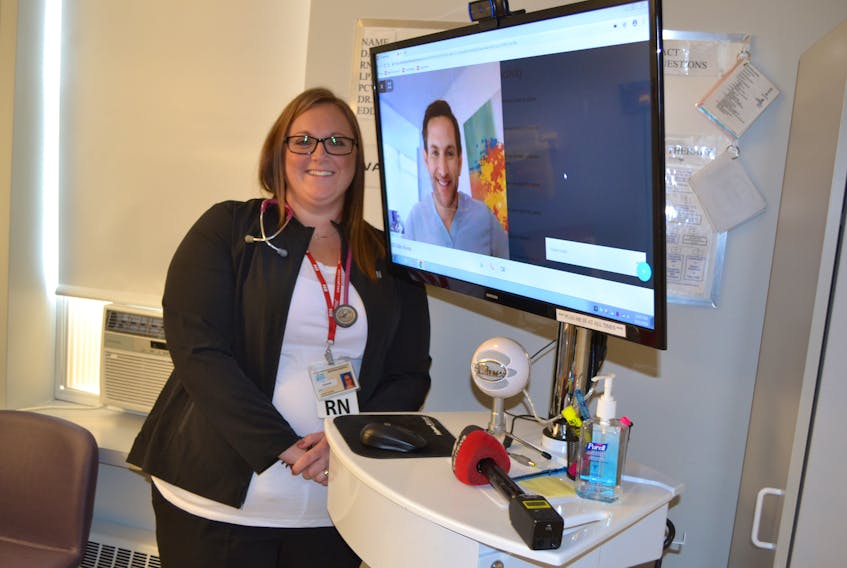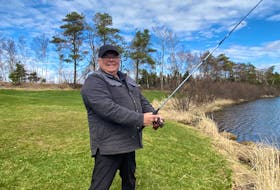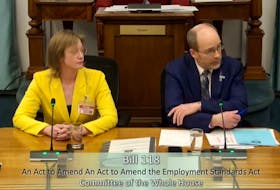ALBERTON, P.E.I. - Western Hospital in Alberton is the first hospital in Canada to pilot a new tele-rounding platform that enables patients to be seen and assessed by a physician who is not physically present.
Tele-rounding was introduced by Maple, a telemedicine company based in Ontario, and has been operational at Western since Aug. 7. There are nine physicians, including three based in P.E.I., signed up by Maple to take turns doing virtual rounds and seeing all of Western’s patients who do not have a family physician.

Stephanie Gaudet, Clinical Nurse Educator for Community Hospitals West, said there are usually anywhere from 13 to 15 unaffiliated patients on the hospital’s acute care ward, and the Maple physician for that day would see all of them. The hospital’s pharmacist is often on the tele-rounds, too, and a physiotherapist or occupational therapist can attend virtually, when needed. The same physician might do virtual rounds for multiple days before handing off to another physician.
Health P.E.I. and Western Hospital recently set up a demonstration to show media how tele-rounding works. Gaudet was the attending nurse for the round and Maple’s CEO, Dr. Brett Belchetz was the tele-rounding physician. Because of patient confidentiality, Western Hospital nurse Chelsea Lewis filled in as the “patient”.
Belchetz, seen on the video screen and watching via video camera, conducted a visual examination of the patient, conversed with her and then instructed the nurse to conduct the physical examination.
A Bluetooth-enabled stethescope allows the doctor on the other end of the line to listen for subtle changes to the heartbeat. It can be recorded so that the tele-rounding physician can compare from one day to another.
Photos of incisions, rashes, etc., can be taken and saved on the clinical information system so that the physician doing tele-rounds can assess any changes.
“From the start, patients seemed happy,” Belchetz said.
“They don’t even notice the technology any more. They notice that they’re seeing a doctor and they see a doctor taking good care of them.”
Gaudet acknowledges some patients were nervous and shy and others excited when they heard tele-rounding was being introduced. “Very quickly, they’ve adjusted very well,” she said. “They interact very well.”

“It’s just very exciting to be the first to pilot this out, and also exciting to make sure those patients are cared for from a physician perspective,” Gaudet added.
Dr. Andre Celliers, executive director of Medical Affairs and Legal Services with Health P.E.I., said tele-rounding has been introduced at Western as a bridging tool until the region’s physician complement gets filled up. There is a new physician scheduled to start in West Prince in October and another one next spring.
“I can tell you this: we have had no patient complaints, no staff complaints and no doctor complaints about this,” Celliers said. “It’s been working really well.”
The province pays Maple for the service it provides, and Maple pays the tele-rounding physicians for their consults. Payment is in keeping with the master agreement, he said.
Belchetz accepts that tele-rounding might not be a permanent fix at Western, but he welcomes the opportunity to have it evaluated, confident it has great potential, especially in small rural hospitals that are having difficulty attracting full-time physicians. Its effectiveness will be closely evaluated, he said. He pointed out tele-rounding is already used effectively in the U.S and the UK.
“We wanted to make sure the patients were comfortable and happy with it. We’re about a month and a half in and, so far, the patients are really, really happy with the process.”
Belchetz said they will be comparing the level of care provided through tele-rounding as compared to being physically present. Length-of-stay and re-admission rates will also be compared, he said.
Prior to tele-rounding, Gaudet said one physician was working tremendous amount of hours to cover the unaffiliated patients. “It just got to the point where it wasn’t sustainable anymore.”
“We had to come up with another approach that would allow the patients of West Prince to receive the care they deserve,” she said.









